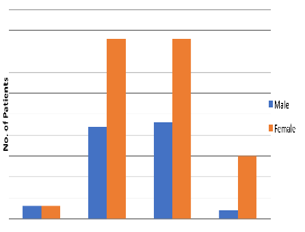Abstract
T2 DM is emerging as a constant threat globally. It has more scope of development in developing countries like India. The objective of this study is to determine the drug utilization patterns and outcomes of treatment in terms of metabolic control in type 2 diabetics’ patients, on oral hypoglycemic agent in the OPD, HAHC hospital in south Delhi, India. Patients with established type 2 diabetes (n=174) visiting the outpatient department were interviewed using a structured questionnaire over a period of 4 months. Results showed that prevalence of T2DM found to be more in female most of them from low cast as they are under poverty and low education Majority of patients in this setting were treated with a multiple oral hypoglycemic agent. The most commonly prescribed hypoglycemic agent was biguanides (metformin) insulin sulfonylureas (glimepiride), thiazolidinediones (pioglitazone), alpha-glycosidase inhibitor (miglitol) and dipeptidyl peptidase-4 inhibitor (sitagliptin). Whereas, the most prescribed combination was insulin + metformin. This study concludes that there is utmost need of patient education and focuses on patient counselling to enhance the patient’s compliance for prescribed hypoglycemic agents and concomitant drug. There is a constant need for diet control and blood glucose and HbA1c monitoring. Metabolic control was found to be poor in the study population. Clinical monitoring of patients adherence to prescribed medicine to achieve good glycemic control is recommended. Measures should be taken to improve patient's adherence to the prescribed treatment.
Full text article
Authors

This work is licensed under a Creative Commons Attribution-NonCommercial-NoDerivatives 4.0 International License.

